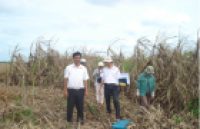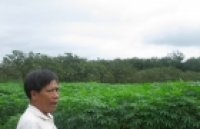| Identification of novel alleles of the rice blast resistance gene Pi54. |
|
Rice blast is one of the most devastating rice diseases and continuous resistance breeding is required to control the disease. The rice blast resistance gene Pi54 initially identified in an Indian cultivar confers broad-spectrum resistance in India. We explored the allelic diversity of the Pi54 gene among 885 Indian rice genotypes that were found resistant in our screening against field mixture of naturally existing M. oryzae strains as well as against five unique strains. |
|
Vasudevan K, Gruissem W, Bhullar NK. Sci Rep. 2015 Oct 26;5:15678. doi: 10.1038/srep15678. http://www.ncbi.nlm.nih.gov/pubmed/26498172 Abstract
Rice blast is one of the most devastating rice diseases and continuous resistance breeding is required to control the disease. The rice blast resistance gene Pi54 initially identified in an Indian cultivar confers broad-spectrum resistance in India. We explored the allelic diversity of the Pi54 gene among 885 Indian rice genotypes that were found resistant in our screening against field mixture of naturally existing M. oryzae strains as well as against five unique strains. These genotypes are also annotated as rice blast resistant in the International Rice Genebank database. Sequence-based allele mining was used to amplify and clone the Pi54 allelic variants. Nine new alleles of Pi54 were identified based on the nucleotide sequence comparison to the Pi54 reference sequence as well as to already known Pi54 alleles. DNA sequence analysis of the newly identified Pi54 alleles revealed several single polymorphic sites, three double deletions and an eight base pair deletion. A SNP-rich region was found between a tyrosine kinase phosphorylation site and the nucleotide binding site (NBS) domain. Together, the newly identified Pi54 alleles expand the allelic series and are candidates for rice blast resistance breeding programs.
Figure: Phylogenetic relationship among Pi54 alleles. Analysis was performed using Pi54 sequences identified in our study material together with previously reported Pi54 sequences from wild rice species and cultivars. The ORF for all the sequences (including the previously reported sequences) were extracted from NCBI database based on the reported ORF for Pi54_Tetep reference sequence. Bootstrap values (1000 replications) are mentioned at the branch nodes. The alleles identified in our study material are labelled in yellow and the reference allele in green. The leaf nodes are coloured purple for wild rice, pink for landraces, green for cultivars, black for unknown status or unknown + breeding lines and blue for landraces + unknown/breeding line/cultivar, respectively.
|
|
|
|
[ Tin tức liên quan ]___________________________________________________
|


 Curently online :
Curently online :
 Total visitors :
Total visitors :
(20).png)


